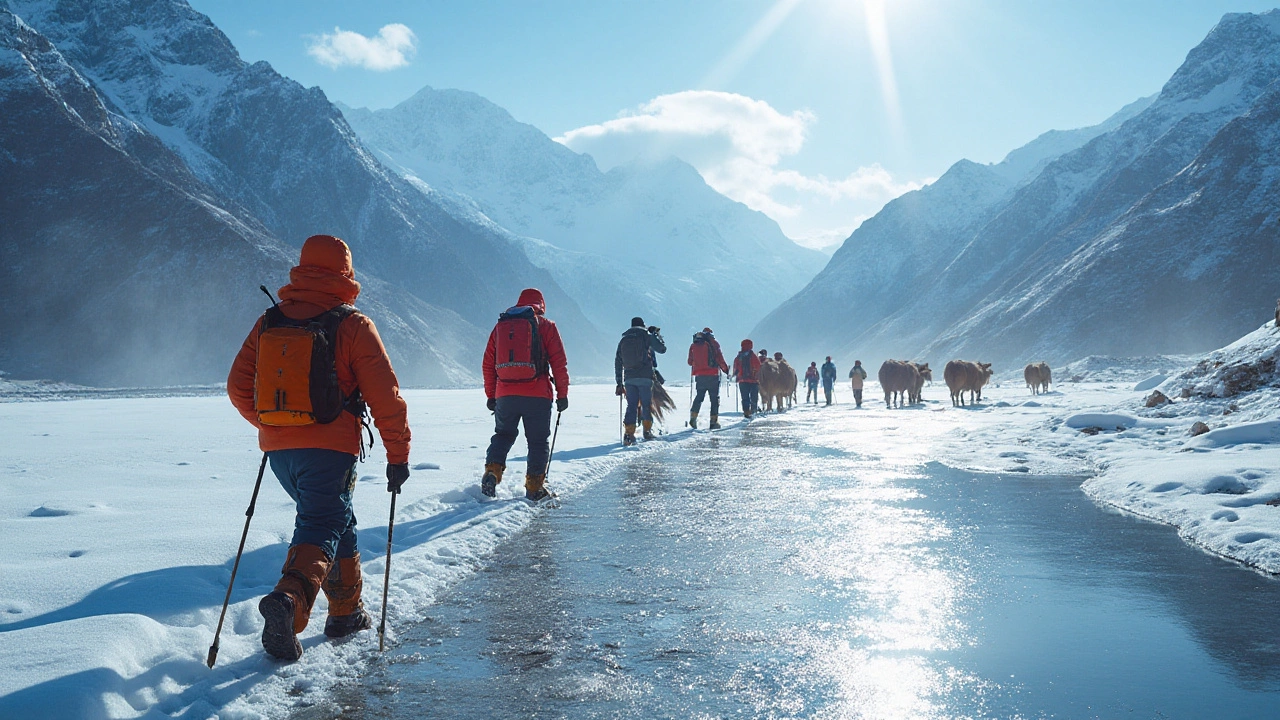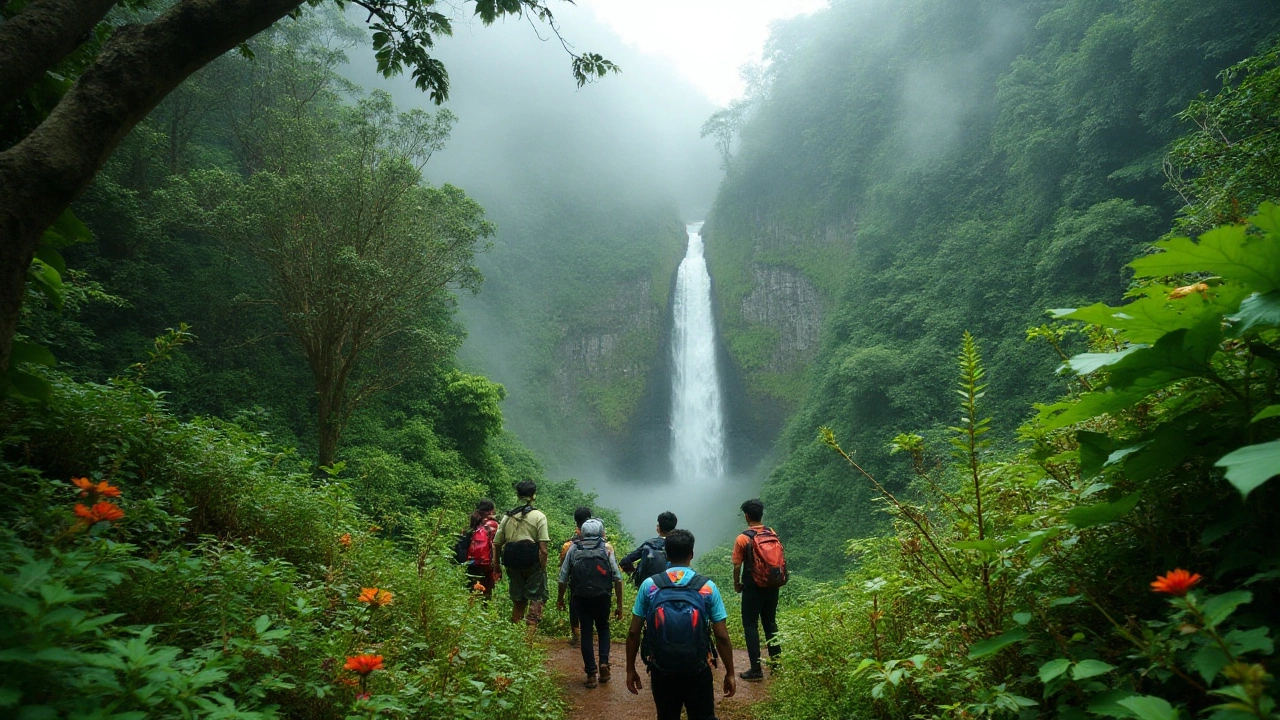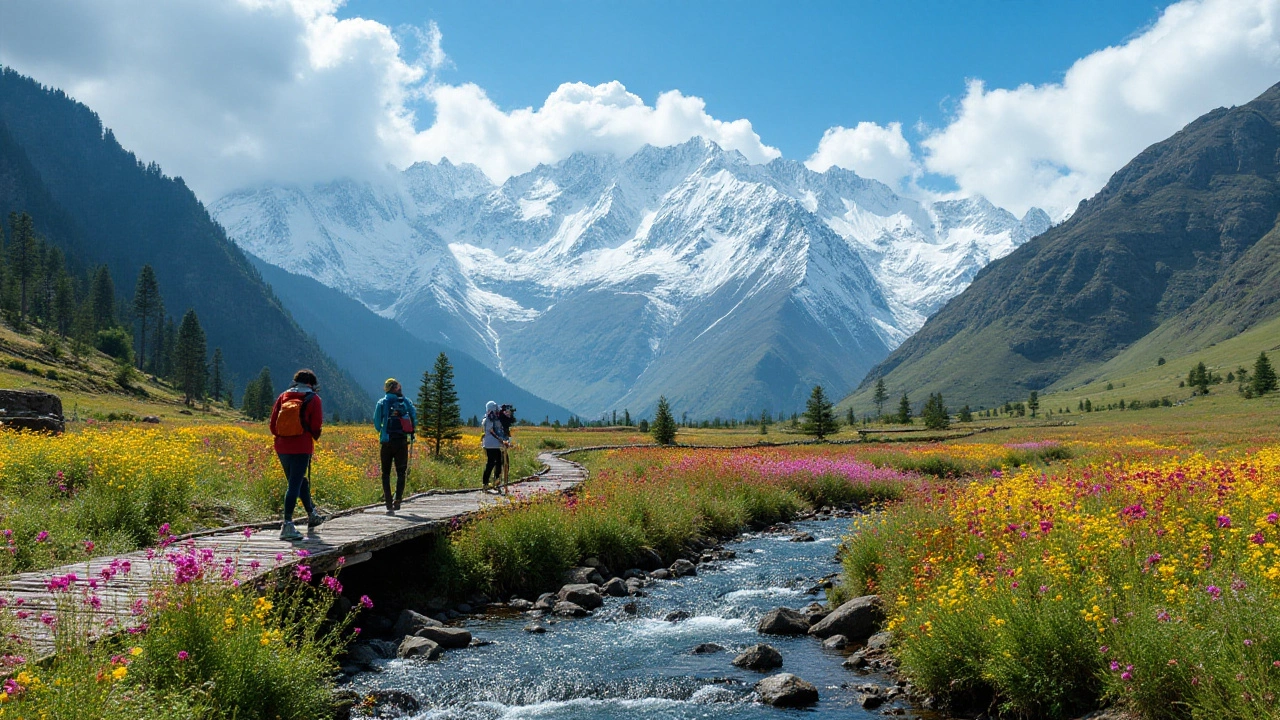Discover the Best Trekking Destinations in India for Unforgettable Adventures
 Jan, 11 2025
Jan, 11 2025
India, with its diverse landscapes and rich heritage, is a paradise for trekking enthusiasts. Each trail, whether in the towering Himalayas or the verdant Western Ghats, promises a breathtaking journey filled with stunning views and unforgettable experiences. With routes that range from beginner-friendly to challenging expeditions, there's something for every level of trekker.
Exploring these trails not only rewards you with natural splendor but also connects you with the local cultures and traditions. These vibrant and age-old customs add a unique essence to your trekking adventure, making the journey much more than just a physical feat. As you embark on such expeditions, knowing what to pack, when to travel, and how to prepare can elevate your entire experience.
- Himalayan Treks
- Western Ghats Trails
- Essential Trekking Gear
- Local Culture and Traditions
- Best Seasons to Trek
- Tips for Beginner Trekkers
Himalayan Treks
The mighty Himalayas have long captured the imagination of adventurers, artists, and mystics alike. This grand mountain range serves as the most prominent destination for trekking in India, where each trail tells its own tale of wonder and challenge. From the famous slopes of Manali to the serene beauty of the Sikkim valleys, the Himalayas present a diverse array of landscapes that entice trekkers from all corners of the globe. Trekking in India through this range is not merely about walking paths but engaging with nature at its most sublime. It's also about immersing oneself in the unique tapestry of local cultures that thrive amidst these towering heights.
One of the most famous Himalayan treks is the Roopkund Trek, which appeals to those intrigued by mystery and beauty. This trek not only offers mesmerizing views of the snowy peaks but also leads to the enigmatic Roopkund Lake, known for its ancient skeletal remains. As hikers ascend the rugged trails, they are treated to sights of lush meadows, dense forests, and finally, the awe-inspiring sweep of ice and snow. Another prominent trek is the Valley of Flowers – a UNESCO World Heritage Site – where during the monsoon season, a vivid spectrum of wildflowers blankets the landscape, creating a surreal spectacle that must be seen to be believed.
If you seek a spiritual touch to your adventure, the Kedarkantha Trek might be your ideal journey. This trek takes you through remote villages where ancient traditions and warm hospitality merge, offering insights into local life that are as enriching as the climb itself. From December to April, the snow-covered trail becomes a winter wonderland, making this a popular destination for those yearning for a white trekking experience. The Kedarkantha Summit offers panoramic views of the nearby peaks, rewarding climbers with a majestic snapshot of the mightiest mountains.
The allure of these Himalayan trails is enhanced further by the rich variety of flora and fauna that grace these regions. Trekkers might encounter the rare Himalayan blue sheep or spot the ever-elusive snow leopard, depending on the routes they explore. As Sir Edmund Hillary, the first known person to summit Everest, once said, "It is not the mountain we conquer but ourselves." His words resonate with many who embolden the spirit of adventure and self-discovery while trekking in these mountains.
For a comprehensive trekking experience, some tour operators offer guided treks which include not only the route but an immersion into the regional folklore and local cuisine. Engaging with community guides provides trekkers with a cultural lens through which to view the vast landscapes. To aid trekkers in planning their adventures, here's a glimpse of Indian treks along with their seasonal recommendations and notable features:
| Trek Name | Best Season | Highlights |
|---|---|---|
| Roopkund Trek | May to October | Skeletal Lake, High Altitude Meadows |
| Valley of Flowers | July to September | UNESCO World Heritage, Rich Flora |
| Kedarkantha Trek | December to April | Snowy Trails, Cultural Villages |
Embracing the spirit of the Himalayas through a trekking expedition is an undeniably transformative experience. Each trek, brimming with unique challenges and awe-inspiring panoramas, nurtures a deep respect and understanding of nature's grandeur. Whether you're a seasoned hiker or a first-time adventurer, the Himalayas offer a veritable paradise for those ready to venture into the heart of India's majestic mountains.
Western Ghats Trails
The Western Ghats stretch over 1,600 kilometers, parallel to the western coast of India. This UNESCO World Heritage Site holds the title of one of the world's eight 'hottest hotspots' of biological diversity. A trek through these ancient hills is like stepping into a sprawling theater of nature's wonders, where the rolling hills, symphonic bird calls, and symphonies of colors create an unforgettable adventure.
The most sought-after trails include the Kumara Parvatha trek, which is often hailed as a rite of passage for trekkers in the south. It towers at an impressive height of 1,712 meters and offers a grueling yet rewarding challenge. This trek takes you through the Pushpagiri Wildlife Sanctuary, home to a multitude of exotic flora and fauna. The highlight of this trek, the 'Shola' grasslands, spread across the peaks, offer unparalleled views of the surrounding valleys and forests.
Trekking in Evergreen Forests
Another popular trek is the Chembra Peak, nestled in the heart of Wayanad district, Kerala. Rising 2,100 meters above sea level, the trail offers an exciting journey through tea plantations and thick forests. Trekkers can spot the famous heart-shaped lake halfway up, which remains mist-laden and is considered perennial. Legend has it that the mountains and forests here echo tales of myth and magic, whispers of the past carried with each breeze.
"The landscapes of the Western Ghats are mystical in a way that few places are. The delicate interplay between light and shadow across the valleys is enchanting," a naturalist once observed.
Essential Trekking Tips for the Western Ghats
When trekking in the Western Ghats, it's crucial to prepare for varying weather conditions. From soaking monsoon showers to the bright and dry sunlight, the weather can be as dramatic as the scenery itself. Make sure to carry a sturdy pair of hiking boots, rain gear, and a hydration pack. Early planning can be key to a successful trek, as some trails may require permits due to their protected status. It's advisable to plan your trek between November and March when the trails are in their prime condition.
Trekking in India through the Western Ghats is not just an expedition into the natural world but an immersive experience into the vibrant cultural tapestry of India. Meeting the indigenous communities and understanding their sustainable ways of living can add a rich layer to your trekking journey. These trails are not just pathways through mountains; they are a gateway into understanding India’s harmonious blend of nature and tradition.

Essential Trekking Gear
Embarking on a journey through India's diverse trekking paths truly requires careful preparation, especially when it comes to packing the right trekking gear. The right equipment not only makes your adventure more comfortable but also ensures safety and allows you to fully enjoy the experience of trekking in India. The unpredictable weather, challenging terrains, and remote locations mean you need to be ready for a range of scenarios, from chilling cold to rainfall as well as rigorous hikes that demand good support and comfort from your gear.
A good quality backpack is the cornerstone of your prep kit. It should not be too bulky yet spacious enough to hold essentials like a sleeping bag, water bottles, snacks, and clothing. Pay attention to the weight distribution features; modern backpacks have ergonomic designs that lessen the burden on your back. Alongside the backpack, opt for trekking shoes that provide excellent grip and support, especially on rugged trails that may be common in regions like the Himalayas. Check for waterproof features, as sudden rain showers can hit unexpectedly during treks like those in the Western Ghats.
Layering is another key consideration, as temperatures can vary significantly. Begin with a good set of moisture-wicking base layers, followed by insulating layers such as fleece or down jackets. Finally, carry a waterproof and windproof shell to protect against rain and chill winds that are often encountered on high-altitude treks. If you plan to trek during the colder months, hand warmers and thermal wear are well worth the added weight. Trekking in India also demands headgear for sun protection and gloves with a good grip if your trek involves scaling rocky paths.
In the words of acclaimed climber, Reinhold Messner, "Adventure does not need to be 'liked'. It needs to be experienced." His wisdom reminds us that thorough preparation allows the full embrace of the journey.
Not to be overlooked, a portable first-aid kit is indispensable. This kit should include band-aids, antiseptic wipes, blister pads, and any personal medication. High-altitude treks like those in Ladakh often cause altitude sickness; therefore, carrying Diamox or similar medication can be vital. Additionally, trekking poles can be incredibly helpful for maintaining balance and reducing strain. Many find these especially beneficial during long descents as they help protect knees from impact.
For tech-savvy trekkers, carrying a lightweight power bank keeps your devices charged, ensuring you capture every breathtaking moment without worry. Maps, either digital or physical, alongside a reliable GPS device, are valuable for navigation through India's expansive trekking routes. A headlamp with extra batteries is a must-have for early morning or late evening treks. Should you need to pitch a tent, ensure your gear includes a durable tent and sleeping mat, preferable for treks that extend multiple days through uninhabited locations. Trekking in varying terrains and altitudes, such as those found in India, calls for mindfulness in packing so that each item contributes to a safer and richer experience.
Local Culture and Traditions
When you set foot on the trekking trails of India, you aren't just stepping into nature's grand gallery but walking through the veins of its rich cultural tapestry. Each path has a story of its own — stories of centuries-old traditions intertwined with the land and its people. In the scenic sprawl of the Himalayan Treks, for instance, you encounter the heartwarming hospitality of the mountain villages. The locals, often seen bustling in their traditional garments, welcome trekkers with a warmth that seems as boundless as the mountains themselves. Here, the peaceful practice of Buddhism is etched into the daily fabric of life, with fluttering prayer flags coloring the landscape, each whispering a silent mantra of goodwill in the brisk mountain breeze. It's an unending sense of calmness that cements the Himalayas as not just a trekkers' haven but a spiritual retreat as well.
Down south, the lush green canopies of the Western Ghats Trails intertwine with the vibrant cultures of Kerala and Karnataka, offering a different, yet equally fascinating cultural immersion. The rich tapestry of local festivals, like the exuberant Onam or the colorful Kambala, perfectly complements the umbrella of dense forests that envelope the Ghats. Within this noise of nature, you hear a deep-rooted respect for the elements, an ancient wisdom passed down through generations. Tribal communities in the Ghats open their doors, sharing tales of folklore that speak of their relationship with the land, a bond of coexistence and reverence. Imagine passing through a village just in time to catch a traditional Theyyam performance, an energetic dance that speaks volumes of the region’s mythological stories.
Witnessing local customs and partaking in these traditions often add an unexpected layer of adventure to any Indian trek. Even a simple homestay experience offers more than just shelter; it's a window into the soul of the region's culture. The culinary delight of feasting on local foods — from the spicy Momos and Thukpa of the Himalayas to the tangy fish curry of Kerala — invites you into a world of tastes that tell their own stories. A 2022 survey by the Indian Ministry of Tourism highlighted that 40% of trekkers cited cultural exchange as one of the most rewarding aspects of their travels.
"To know India, you must experience her people," noted acclaimed author and historian William Dalrymple. "Every trail is but a thread in a vast, intricate tapestry of life."Such experiences amplify the trekking journey, casting long shadows of memories that stretch well beyond the horizon of your travels. Embracing the cultures enriches every step, turning an already grand adventure into a deeply personal voyage of discovery.

Best Seasons to Trek
Choosing the right time to embark on a trekking adventure in India is crucial for an enjoyable and safe experience. The country's vast geography means different regions have distinct climates, affecting the trekking conditions. For those eyeing the majestic Himalayan treks, the months from May to October are ideal. During these months, the harsh winter snows melt, opening up trails in Himachal Pradesh, Uttarakhand, and Kashmir. As temperatures become more bearable, the skies clear to reveal breathtaking views of snow-capped peaks. It’s a period when treks like the Valley of Flowers and Roopkund are vibrant with nature’s splendors.
Conversely, the Western Ghats are best explored during the winter months from October to February. This period marks the end of the monsoon and brings a pleasant, cool climate perfect for trekking. Lush greenery and sparkling waterfalls greet trekkers, especially in places like Kerala’s Silent Valley and Karnataka’s Kudremukh. Staying updated on weather forecasts is advisable as sudden showers can still surprise. Timing your treks during these optimal seasons can enhance the overall experience, as they not only offer the right climatic conditions but also ensure safety on various trekking routes.
An interesting aspect of Indian treks is their transformation with the changing seasons. The monsoon months from July to September paint places like the Sahyadris in Maharashtra with rich, green foliage, while the Indus Valley in Ladakh remains arid, permitting adventure under a uniquely clear sky. In contrast, the summer heat in central and southern India can prove challenging for trekkers. Choosing the right trek during its prime season can mean the difference between a comfortable journey and one laden with weather-induced obstacles. Proper planning aids in making the most of the adventure, experiencing nature’s beauty at its finest.
As per advice from seasoned trekkers and professionals, focusing on weather patterns and geographical conditions for each destination can ensure more enjoyable treks.
"The Indian subcontinent offers a diverse range of trekking experiences, and understanding the best seasonal windows guarantees the adventure of a lifetime," remarked a renowned travel guide in one of National Geographic’s explorations.Trekking outside the recommended seasons may not only affect the scenery but can also pose risks due to extreme weather conditions, making it essential to plan accordingly.
For those gearing up for their first Indian trek, studying different destinations and their specific weather nuances is essential. Many trekkers recommend creating a seasonal calendar that marks the best times for various routes. This strategy aids adventure seekers in determining when to book travel plans and what clothing and gear essentials to pack. With careful planning and accurate information, each trek can turn into a spectacular journey across India's remarkable landscapes.
Tips for Beginner Trekkers
Starting a trekking journey can be an exhilarating adventure, especially if you're venturing into some of the best trekking places in India. However, for beginners, it's essential to approach this endeavor with careful preparation and knowledge. Your first step should be selecting a trek that matches your level of fitness and experience. India offers a wide range of trails, so choose a trek that's less challenging to ensure a comfortable and enjoyable experience. Begin with shorter routes, gradually increasing the distance as you gain confidence and stamina.
Equipping yourself with the right gear is another crucial aspect of trekking. Invest in a good pair of trekking boots— they provide much-needed support and prevent injuries on uneven surfaces. It's also wise to have layered clothing to adjust to the changing weather conditions. Don't forget essentials like a waterproof jacket, trekking poles, and a sturdy backpack. Staying hydrated is key, so carry a water bottle and purification tablets if you're unsure about the water sources along the way.
Physical preparation prior to your trekking venture cannot be understated. Building endurance through regular exercises like jogging, cycling or swimming can make the trek less daunting. Incorporate strength training for your legs and core, as these muscle groups play a pivotal role in maintaining balance on uneven terrain. Stamina and strength are not built overnight, so give yourself a few weeks to train regularly before the trek.
Understanding the cultural and natural environment of the region you intend to explore can greatly enrich your trekking experience. Respect local traditions, and be mindful of the natural landscape. Trekkers often share how engaging with local communities created some of their most profound memories. As one expert climber noted, “The essence of trekking isn't just in reaching the summit, but in the journey itself and the people you meet along the way.”
Adapting to high altitudes is something many beginners overlook. The higher you go, the less oxygen is available. Proper acclimatization is essential to avoid altitude sickness. Resting sufficiently and ascending gradually can minimize risks. If symptoms like headaches or dizziness occur, it's crucial to listen to your body and descend to a lower altitude.
Mother nature is unpredictable, so always prioritize safety. Keep a copy of the trek map and let someone know your itinerary. Trekking in groups is safer, especially for newcomers. Even if you begin with a smaller trek, these principles and preparations are vital. With the right mindset and preparation, your journey through the best trekking places in India can be a life-changing adventure.